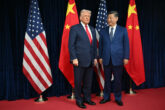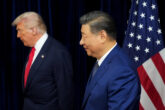January 04, 2022
China’s Nuclear Buildup is About More Than Nukes
U.S.-China nuclear and strategic stability will be tested in the coming year after a spate of revelations in 2021 about Beijing’s nuclear program. It is expanding the size and sophistication of its arsenal, potentially growing its total stockpile to 1,000 warheads by 2030, or just over a quarter of America’s 3,800 warheads. China also has tested a weapon system that flies into orbit carrying a hypersonic weapon — missile systems that fly five times the speed of sound and can maneuver to avoid defenses — and dug hundreds of new silos for intercontinental ballistic missiles (ICBMs). In addition, Beijing is reportedly consolidating its nuclear triad of bombers, submarines, and ICBMs; moving to a launch-on-warning posture; and exploring new “exotic” nuclear systems.
These developments raise questions about what is motivating China to pursue such capabilities, how nuclear modernization connects to the larger regional security dynamic, and how Washington should respond. The multitude of technical intricacies in this area — from the features of particular weapons systems to nuclear deterrence logic — are (understandably) often difficult for non-specialists to get their arms around. It is possible to understand the overall picture, though, by examining the issues as four concentric circles that show how nuclear-specific issues intertwine with broader concerns in both Beijing and Washington about advanced conventional capabilities and U.S.-China competition overall.
Pursuing nuclear and strategic stability between the United States and China will likely prove harder than ever — but it is perhaps more important than ever, too.
The first and innermost circle contains the nuclear weapons themselves, along with missile defenses, including the advancements mentioned earlier. China’s objectives are not all clear. Beijing certainly wants to ensure it can conduct a retaliatory strike if the United States or another country bombed China first; that capability undergirds nuclear deterrence. Chinese leaders likely also seek to deter the United States from credibly threatening to use nuclear weapons in a regional conflict, say over Taiwan, if China gained an advantage with its conventional forces.
Another more speculative ambition, but one voiced by the head of U.S. Strategic Command, among others, is that China is trying to “break out” of being a second-tier nuclear power and sprint to parity with the United States and Russia. This would constitute a sea change in Beijing’s nuclear strategy, but it would be consistent with President Xi Jinping’s stated aim to build a “world-class military” generally and “high-caliber strategic deterrence systems” specifically. China under Xi has carried out a more aggressive foreign and security policy across the board. Plus, military power and prestige help boost the regime’s legitimacy at home as well as its global status.
Read the full article from Just Security.
More from CNAS
-
Chinese Maker of Bitcoin-Mining Machines Is a Security Threat, Says Expert
Bloomberg News reports that a Chinese manufacturer, Bitmain Technologies Ltd, that sells most of the world’s Bitcoin-mining machines — including 16,000 of them to a venture ba...
By David Feith
-
Indo-Pacific Security / Energy, Economics & Security
North Korea’s Provocations, Power Plays, and Shifting AlliancesTensions on the Korean Peninsula have reached a new and dangerous threshold. President Lee Jae Myung is warning of a real risk of accidental military clashes, as the situation...
By Dr. Go Myong-Hyun
-
Indo-Pacific Security / Energy, Economics & Security
How to Win the Economic War with ChinaTrump's approach to China has run aground, giving Beijing unprecedented advantage in the economic conflict....
By Edward Fishman & Julian Gewirtz
-
Indo-Pacific Security / Technology & National Security
Sharper: Tech + ChinaRecent talks between President Donald Trump and Chinese Communist Party General Secretary Xi Jinping placed a spotlight on emerging technologies, from high-end chips to minera...
By Charles Horn & Sevi Silvia




